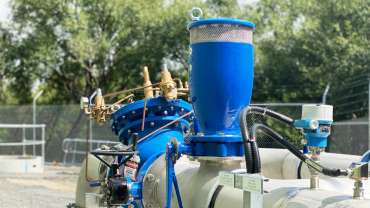WPD mechanical meters by Sensus, NMI approved
![photo (31) three blue water pressure meters next to each other in front of a fence]()
Learn how to install the Sensus WP-Dynamic water meter with our guide to metering terminology and best-practice set up.
The Sensus WP-Dynamic water meter is NMI pattern approved in Australia for inclusion in non-urban water installations.
The high quality turbine meter is essential within these projects, and needs to be installed in accordance with government requirements, relevant standards, certifications, and approvals in addition to the manufacturer’s recommendations and project requirements.
Meter terminology
When looking at the product data sheet, it’s important to understand the relevant metering terminology:
Q1 : This is the minimum flow rate suggested for the meter to operate within the optimum accuracy range.
Q3 : This is the maximum continuous flow rate suggested for the meter to operate within the optimum accuracy range.
Q4 : This is the maximum short burst flow rate suggested for the meter to operate within the optimum accuracy range.
The maximum ranges should be avoided where practical, as operation at high flows can cause excessive wear in the meter over long periods. The wear is also dependent on the water quality passing through the meter.

The Sensus WP-Dynamic water meter installed as part of a waterworks pipeline.
Installation
When designing the installation pipework, we recommend considering the following points:
- The meter should be sized to ensure that the selected diameter (DN) will operate correctly within the meter manufacturer’s recommendations.
- It is also essential that you consider any recommendations provided by the Australian government, who may have different flow requirements to the manufacturer.
- The mating pipework upstream and downstream should be as close as practical to the inside diameter of the meter.
- The gasket used between the meter and the mating flange should be correctly sized. Gaskets used with a smaller ID than the meter will cause issues with meter accuracy.
- The pipework should be designed so that the meter is always full of water. Entrapped air can cause issues with meter accuracy. If in doubt, ensure you install combination air valves close to the meter to avoid entrapped air.
- If the meter is dry during stationary conditions, large volumes of air passing through the meter on pump start can cause excessive wear on the meter and inaccuracy in the totaliser.
- We suggest you contact our team to select a correct air release valve to ensure air is released prior to the meter to avoid excessive wear becoming an issue.
- Ensure all mating pipework has been flushed of dirt and debris prior to bringing the meter on line.
- If there is potential contamination in the water flow, you should install the Sensus WP-F dirt box strainer to help protect the meter.
We’re here to help
If you’d like to learn more about our WP-Dynamic water meter, visit our online product page, or get in touch with your local sales office for support.
Make enquiry
Online Enquiry Close

Learn how to install the Sensus WP-Dynamic water meter with our guide to metering terminology and best-practice set up.
The Sensus WP-Dynamic water meter is NMI pattern approved in Australia for inclusion in non-urban water installations.
The high quality turbine meter is essential within these projects, and needs to be installed in accordance with government requirements, relevant standards, certifications, and approvals in addition to the manufacturer’s recommendations and project requirements.
Meter terminology
When looking at the product data sheet, it’s important to understand the relevant metering terminology:
Q1 : This is the minimum flow rate suggested for the meter to operate within the optimum accuracy range.
Q3 : This is the maximum continuous flow rate suggested for the meter to operate within the optimum accuracy range.
Q4 : This is the maximum short burst flow rate suggested for the meter to operate within the optimum accuracy range.
The maximum ranges should be avoided where practical, as operation at high flows can cause excessive wear in the meter over long periods. The wear is also dependent on the water quality passing through the meter.
The Sensus WP-Dynamic water meter installed as part of a waterworks pipeline.
Installation
When designing the installation pipework, we recommend considering the following points:
- The meter should be sized to ensure that the selected diameter (DN) will operate correctly within the meter manufacturer’s recommendations.
- It is also essential that you consider any recommendations provided by the Australian government, who may have different flow requirements to the manufacturer.
- The mating pipework upstream and downstream should be as close as practical to the inside diameter of the meter.
- The gasket used between the meter and the mating flange should be correctly sized. Gaskets used with a smaller ID than the meter will cause issues with meter accuracy.
- The pipework should be designed so that the meter is always full of water. Entrapped air can cause issues with meter accuracy. If in doubt, ensure you install combination air valves close to the meter to avoid entrapped air.
- If the meter is dry during stationary conditions, large volumes of air passing through the meter on pump start can cause excessive wear on the meter and inaccuracy in the totaliser.
- We suggest you contact our team to select a correct air release valve to ensure air is released prior to the meter to avoid excessive wear becoming an issue.
- Ensure all mating pipework has been flushed of dirt and debris prior to bringing the meter on line.
- If there is potential contamination in the water flow, you should install the Sensus WP-F dirt box strainer to help protect the meter.
We’re here to help
If you’d like to learn more about our WP-Dynamic water meter, visit our online product page, or get in touch with your local sales office for support.
Make enquiry



